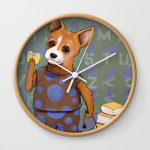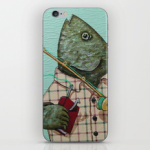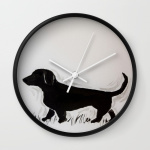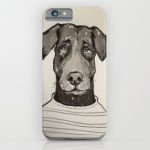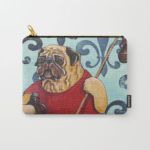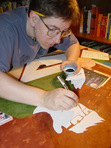Sue Clancy's Blog, page 47
April 25, 2017
what café art became
I blogged earlier about my café inspired pattern design in the process of being created – https://sueclancy.com/2017/04/25/cafe-art-you-and-me/
The rest of that story is that I’ve turned the “café you and me” design into a scarf and a clutch bag for my signature art apparel collection on VIDA https://shopvida.com/collections/sue-clancy
Now I need more coffee…
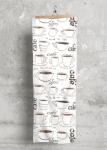
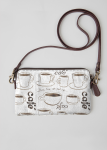

café art you and me
I’ve been inspired by all the coffee here in the Pacific Northwest and enjoying going to the cafe’s and coffee shops with my sweetie. And yes, we’ve been buying coffee beans from local roasters and “trying it at home”.
Here’s a café inspired pattern design that I’m in the process of creating using a brush and walnut ink.
[image error]

April 23, 2017
soothing the green dragons
One of my favorite leisure activities is to get a book out and settle in to my “lair”. Reading soothes the savage imaginary beast! So I’m creating some clocks, tote bags and other fun stuff with this image that I’ve titled “Dragon A Book Out”. https://society6.com/sue clancy And of course there are other art images of mine on stuff there…
[image error]

April 20, 2017
art of songbirds on blooms
Early one morning I was standing outside waiting on Rusty, my dachshund, to “do his business” and saw several song birds singing in my blooming Camilla bush. I doodled an idea in my sketchbook using a ball-point pen. (Yes, I keep a pen and sketchbook in the pocket of my bathrobe) By the time Rusty had finished up “business” I’d finished my sketchbook work. A few days later I began creating a finished surface design inspired by those song birds. Here is my artwork in progress:
[image error]
To create this design I’m using my cut paper mixed media collage technique – the same one that I use to create my fine art.
Then after several more days of “short burst” work on my design I declared it “finished” and submitted it to VIDA for addition to my signature collection: http://www.shopvida.com/collections/sue-clancy
Here are the two newest “signature collection” apparel pieces with my “Songbirds On Blooms” design:
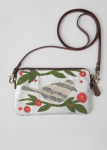
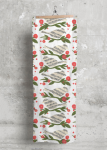
And of course I’ve a few more plans for this design but more about that later.

April 18, 2017
designing a creative life 3 ways
“Art cannot be separated from life. It is the expression of the greatest need of which life is capable. And we value art not because of the skilled product, but because of its revelation of a life’s experience.” – Robert Henri (American painter).
I’ve been thinking of that quote today – and thinking of the people who have told me that they want to “be more creative” but aren’t sure how to start or what to draw. I’ve been thinking of how easy it is now for me to find subject matter. But it wasn’t always so.
As a young art student one of my first college assignments was to “do a 4 foot by 4-foot painting in acrylic of any subject matter but it cannot be abstract.” Well that was a stumper. What to paint? My professor went on to tell my class about how we needed to look around our own lives, our own experiences and find subject matter there.
That helped somewhat but still… what to make art about? My college life seemed boring and un-dramatic. How to identify subject matter I cared about?
I muddled through the school assignment and over the years got better at coming up with subject matter. It took even more time for me to figure out that a system of “short bursts of creativity” worked best for me but here’s what I’ve learned on my personal quest for the fountain of continually-interesting-to-me artistic subject matter:
A. Keep a daily sketchbook, 5 to 10 minutes of work at a time, in which I draw or write about anything that occurs during a day that “catches my attention”. No censorship. No “trying to make art”. Just make notes, doodles. Play. Note the fun stuff, the things I’m grateful for and things that make me laugh or feel curious.
B. After several weeks or months of sketchbook work I look back through my book and notice any reoccurring themes and I list them.
C. I select one of the themes and set a series of creative appointments with myself to do a “real drawing” of that theme using good art materials. The creative appointments are 10 to 20 minutes of work/play at a time. I purposefully keep these sessions short! Repeat the creative appointments (aka short bursts of creativity) until the drawing is finished.
Then I select that same theme – or a similar one from my sketchbook – and do another “real drawing” – trying to do an even better job of communicating my thought or feeling. Again, no censorship, no “trying to make great art” – just trying to draw as neatly as possible, to convey as clearly as possible what “caught my attention”.
I keep working in my sketchbook every day even when I have a creative appointment with myself. Both of these 10 minute activities go on behind the scenes of my very busy professional artist life – and this “short bursts” concept could work within anyone’s “too busy” life and add more ongoing creativity. (Also, this concept builds on my “designing habits” concept from an earlier blog post: https://sueclancy.com/2017/03/29/designing-habits-6-ways/ )
Here’s a visual-thinking-drawing I did that describes this in a different way:
[image error]
For me it has turned out that creativity is a lot like happiness – it follows me wherever I go. Below is a cartoon I drew about happiness that explains this concept in yet another way – it’s from “Dr. Bob’s Emotional Repair Program First Aid Kit” https://store.bookbaby.com/book/dr-bobs-emotional-repair-program-first-aid-kit
[image error]
page from “Dr. Bob’s Emotional Repair Program First Aid Kit” https://store.bookbaby.com/book/dr-bobs-emotional-repair-program-first-aid-kit
You can also see one of my published sketchbooks as an ebook here: https://store.bookbaby.com/book/coffee-table-book

April 14, 2017
cephalopods and the art of small things
Yesterday I read an article titled “Cephalopods Adapt By Editing Their Genes” and that reminded me of the value in periodically examining our own assumptions, our own stories, our own worldview and being willing to rearrange our own mental furniture.
Perhaps adapting or editing the stories you tell yourself is the human equivalent of editing genetic code as a cephalopod?
Reexamining stories, assumptions and the kinds of questions you ask are also keys to creative thinking.
I’ve noticed that the kinds of questions a person asks makes a difference in creative thinking. For example asking “How can I include at least one fresh vegetable in this meal?” elicits a more exciting creative response than the question “How can I eat more healthfully?”
Likewise asking the small question “What art medium/technique would be most fun to use to depict my favorite food?” provokes a more joyous creative response than the question “What fine art can I make on a universal theme?”
Most days I wake up thinking “what small thought can I think about or re-think about today?”
So today’s small things I’m thinking about are pictured here:
[image error]
By list:
“Cephalopods adapt by editing their genes” http://www.columbian.com/news/2017/apr/13/cephalopods-adapt-by-editing-their-genes/
“The Drunken Botanist” by Amy Stewart
“Creative, Inc.” by Meg Mateo Ilasco & Joy Cho
A postcard of “Chaco Culture” a National Historical Park in New Mexico
My coffee cup and a glass marble.
And to put the concept in this blog post yet another way: Here is a page from my book “Dr. Bob’s Emotional Repair Program First Aid Kit” https://store.bookbaby.com/book/dr-bobs-emotional-repair-program-first-aid-kit
[image error]

April 11, 2017
art of quick coffee
I’ve been very busy with art commissions and upcoming art exhibit work lately – but thank goodness for my practice of making a creative appointment with myself. When I do this I set aside 5 to 15 minutes to do a “quick study” on one of my regular themes…. it’s a way to take a breather, meditate/think on a topic while doing something creative.
Here’s a recent “quick study”:
[image error]
“Arlie” by Clancy – ink on handmade paper.
You can see more art like this in my recent book “Dogs by Sue Clancy” https://store.bookbaby.com/book/Dogs-By-Sue-Clancy
[image error]April 7, 2017
art of onions chopped
I finished the artwork I was working on in my last blog post! https://sueclancy.com/2017/04/06/art-of-the-onion/ and then I applied the illustration to some things… a framed print, greeting cards and other items you can find here: https://society6.com/sueclancy
[image error]
https://society6.com/sueclancy

April 6, 2017
art of the onion
About a month ago now Sweetie and I took a cooking class (www.class-cooking.com) as a “date night out”. It was fun and as usual when I do something fun I made notes in my sketchbook. Here is one of the sketchbook pages I did during cooking class with Chef Kim Mahan.
[image error]
Then I got very busy with fine art commissions and etc. freelance projects – and life.
But every time I’d cut an onion when cooking supper I’d think about our class and the valuable instructions I’d gotten about onions. Since for me drawing is thinking – I ached to draw onions and the chef’s “how to chop onions” instructions so as to think about and “visualize” them. So for several weeks now when I’ve had a spare 5 or 10 minutes I’d look at my sketchbook pages and brain-storm about what I wanted to create. After a brain-storm option had been settled upon I spent my spare 5 or 10 minutes drawing and writing in pencil on a larger sheet of Bristol paper the onion art/illustration I’d brain-stormed about. Some days I only erased pencil lines that didn’t work. Other days I re-drew pencil lines. After the pencil lines were settled in my spare few moments I’d do an ink line or two…
We’re talking quick-quick drawing work on the “onion art” then I’d go on with my day-job art projects. Every day though I did something in my spare 5 to 10 minutes to inch the onion art along.
Then today I had 20 whole minutes in a row to spare! Wahoo!! And the pencil work was done and I even had a few ink lines done – so I grabbed my ink pens, watercolors and color pencils…
Here’s what I’ve done today – as it is on my work table – I’ve a bit more work to do but it’s almost finished!
[image error]

April 4, 2017
what is art for and 3 ways to find out
Professional artist’s ask themselves “what is art for?” and answer it for themselves because that helps us know why we’re doing what they are doing. And knowing this helps you keep on course.
Here’s a sketchbook page from a time when I was examining this question:
[image error]
For me “art is for” good mental health practice – and to provoke a smile, a chuckle. To quote from my book Dr. Bob’s Emotional Repair Program First Aid Kit “When a negative thought enters your mind just say (inwardly) ‘STOP’. It’s your brain, your mind and you have every right to think the thoughts you want…. Don’t let a negative thought ever finish its sentence…. How many ‘STOP’s are enough? As many as it takes. It is also helpful to keep a list of positive things that you enjoy thinking about or doing, like books/reading, walking… going to art exhibits… playing tennis… and after inwardly saying ‘STOP’ switch your focus to something positive and enjoyable.” (https://store.bookbaby.com/book/dr-bobs-emotional-repair-program-first-aid-kit)
So my goal as a professional artist became to create fine art, books and other objects that are positive and enjoyable for other people to see – switch focus to – and that are also positive and enjoyable for me to create. I decided that the genres of “animal painting” and “genre painting” best fit this goal. For short I call this goal to “feed the good wolf”.
To make sure you know what I mean by that here’s a cartoon excerpt from “Dr. Bob’s Emotional Repair Program First Aid Kit”
[image error]
excerpt from Dr. Bob’s Emotional Repair Program First Aid Kit https://store.bookbaby.com/book/dr-bobs-emotional-repair-program-first-aid-kit
But how exactly did I get to a defined goal, a “purpose” for my art?
I went to lots of art galleries and museums. I read a lot of books. I listened to other people talk about what they enjoyed. Anywhere and everywhere I went I made a quick note of what interested me or fed my “good wolf” in a book that I kept with me at all times.
I looked for art supplies and other opportunities to “test the theory” of whether or not something really did feed my good wolf. For example at one time I thought creating sculpture would be “good wolf food” for me – but I discovered that it was too physically difficult and in the process of creating sculpture I ended up cursing a lot. So after some time spent trying metal sculpture I nixed that one from the “good wolf food” list.
I played with the genres and arts categories while making a note of my responses emotionally, physically, mentally. By “play” I mean I casually went to art exhibits, looked at objects in a store or on-line that fit the genre/category, I tried the genres at home and all the while I noted my gut response – did it feed my ‘good wolf’? Did it make me smile and want to “share it” in some way with a person I love? What is it about that art/object that excites me? Then I list those qualities and pursue them in my own projects! (As I mentioned above it turned out that the animals-in-art genre fit me well!)
Speaking of projects – here’s a very new project for me that fits with my “feed good wolves” goal: I’ve begun designing for iPhone cases, Laptop skins, wall clocks, comforters and many other tech and household objects. (If you noticed that these items fit in the genres of ‘animals in art”, ‘genre painting’ and ‘media arts’ you get a gold star sticker!) The link to my newest project: https://society6.com/sueclancy – and here below are a few examples.
